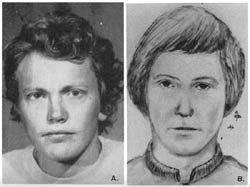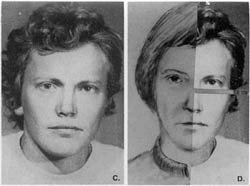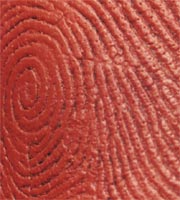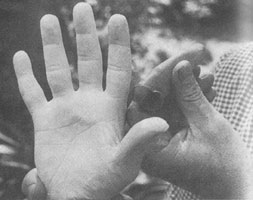| |
| Fabricated
Confession |
| The
Mickelberg brothers have claimed all along that they were framed.
The most damning evidence was the 1982 unsigned confession of
Peter Mickelberg, made without witnesses or legal representation.
The Mickelbergs claimed they'd been "verballed" -
the process by which a confession is written and then presented
as a true account of a police interview. |
|
In
2002, one of the senior detectives has come forward and acknowledged
that the "confession" was indeed fabricated.
Police in Australia can no longer submit unsigned confessions
into court and videotaping of interviews is now a requirement
- largely as a result of this case.
|
| This
page is not intended to suggest whether or not the accused perpetrated
the crime, but rather to allow interested people to assess the
nature of the evidence for themselves. What follows are some
of the exhibits called into question from the original trials
and subsequent appeals. |
| |
| Police
Sketch of a 'Suspect' |
  |
| The
passport photo of Peter (A) that was later used to create an
identikit with wig and glasses and the first police 'impression'
of a suspect in the swindle (B), issued to newspapers four days
after the swindle. The passport photo (C) printed in reverse
bares an uncanny likeness to the freehand police sketch, particularly
noting peculiarities of the nostrils, angle of the eyes and
the mouth. Shading has an eerie likeness, as does the hairline
and neckline. When the two halves are joined (with a small cut
to allow for a slight elongation of the distance between the
nose and eyes) the image is almost that of a mirror (D). The
witnesses who described the suspect in such detail as to cause
the police sketch - not identikit - to be done with such precise
imagery, failed to describe to the artist the main variation
between Peter's passport photo and his normal facial detail:
his prominent, almost buck teeth. |
| |
| Fingerprint
- For Real or Forgery? |
| Fingerprinting
has long been considered as indisputable in the courtroom, and
in the public eye; If Colonel Mustard's prints are found on
the candlestick, he is seen as guilty… |
As
early as 1894, Mark Twain wrote in his book Pudd'nhead Wilson;
"Every human being carries with him from his cradle to
his grave certain physical marks which do not change their character,
and by which he can always be identified - and that without
shade of doubt or question. These marks are his signature, his
physiological autograph, so to speak, and this autograph cannot
be counterfeited… This signature is each man's very own.
There is no duplicate of it among the swarming populations of
the globe!" |
| Of
course, that was before the advent of silicon. It is now becoming
more widely acknowledged that fingerprints can, in fact, be
forged. Experts from Scotland Yard, the F.B.I. and the U.S.
Secret Service testified to the validity of a fingerprint presented
as evidence. Could a fingerprint be faked? |
| |
| US
Court Restricts Fingerprint Testimony. |
| A
federal judge has ruled that fingerprint experts should not
be permitted to tell juries that two fingerprints are a "match,"
because the science they rely on doesn't meet the U.S. Supreme
Court's Daubert test for assessing reliability of scientific
evidence. In United States v. Plaza Senior U.S. District Judge
Louis H. Pollak in Philadelphia stopped short of throwing out
all fingerprint testimony, saying such a ruling would be "unwarrantably
heavy-handed." The ruling may ultimately flow through to
the presentation of DNA and other forensic evidence. (Law News
Network, January 9, 2002). |
| |
|
|
|
 |
|
 |
|
 |
|
| This
enlargement of a rubber cast of Raymond Mickelberg's right
forefinger clearly shows that even the finest details
down to sweat pores were reproduced by the casting. |
|
The
method: a latex rubber glove was first made, illustrated
by the digit held here, into which the silicone was poured.
When dry, hands of intricate detail were produced by Raymond
Mickelberg. |
|
Casts
of hands such as these were acknowledged by police to
have been in their possession before the alleged crime
mark was 'discovered' and found to match Rays' own. The
original evidence was destroyed in suspect circumstances. |
|
|
| |
| Omissions
|
| As
the crown prosecutor stated to the jury in 1983, "The system
under which we operate is that at some stage the police deliver
to the defense the so-called hand-up brief. That is the statement
of all of the evidence of all the witnesses, the people from
the mint and all the police officers." This certainly should
be the case, but sadly was not so for the Mickelbergs. All mention
of alternate suspects, witnesses supporting the accused men's
alibis and any evidence not supporting the prosecution were
simply eliminated, lost or destroyed. The books highlight the
mass of evidence that was omitted from the hand-up brief, plus
interviews with vital witnesses that the police never questioned,
despite their obvious relevance. Yet more evidence was destroyed,
fabricated and 'lost', as shown in "The Mickelberg Stitch",
"Split Image" and the soon-to-be-revealed "Litany
of Lies", by Avon Lovell. |
   |
 |
|
